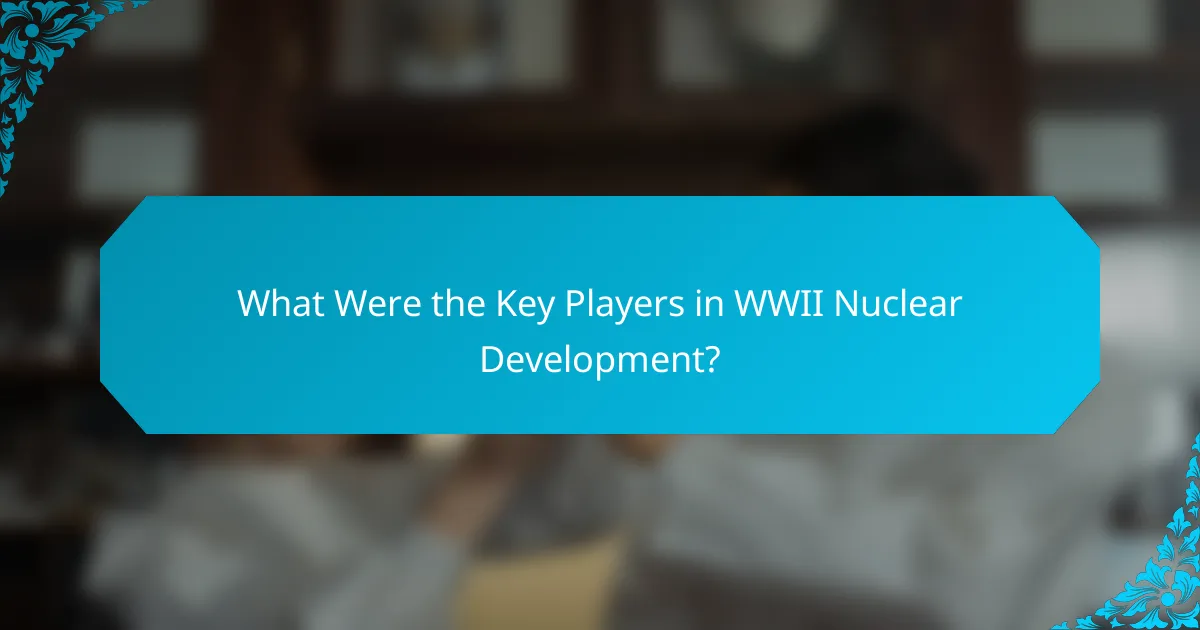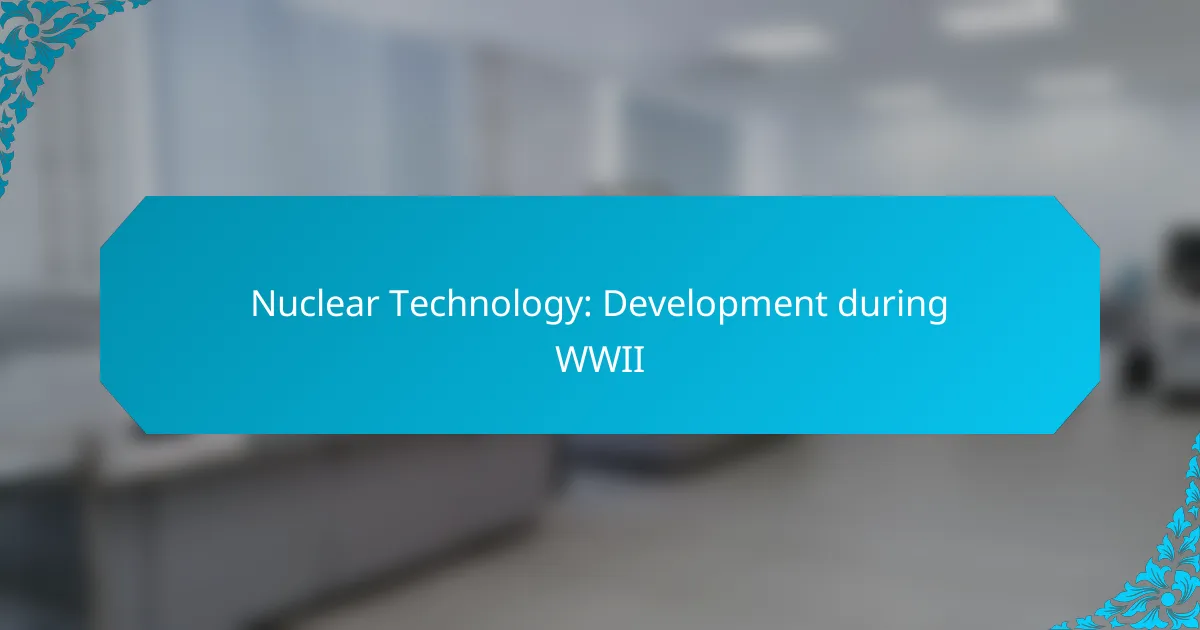During World War II, the urgent need for powerful weapons spurred significant advancements in nuclear technology, most notably through the Manhattan Project. This initiative led to groundbreaking innovations in atomic bomb design and techniques for uranium enrichment and plutonium production. The introduction of atomic bombs not only transformed military strategies but also raised profound ethical questions about their use and the responsibilities of those involved in their development.

What Were the Key Developments in Nuclear Technology During WWII?
During World War II, significant advancements in nuclear technology emerged, primarily driven by the urgent need for powerful weapons. The most notable developments included the establishment of the Manhattan Project, innovations in atomic bomb design, and advancements in uranium enrichment and plutonium production techniques.
Manhattan Project
The Manhattan Project was a secret U.S. government initiative aimed at developing atomic weapons. Initiated in 1942, it brought together some of the brightest scientific minds, including physicists like J. Robert Oppenheimer and Enrico Fermi, to work on nuclear fission research.
This project not only focused on weapon development but also established extensive research facilities across the United States, including Los Alamos, Oak Ridge, and Hanford. The collaboration among scientists and military officials was crucial in accelerating the pace of nuclear research.
Atomic Bomb Design
Atomic bomb design during WWII primarily revolved around two types: the uranium-based “Little Boy” and the plutonium-based “Fat Man.” Little Boy utilized uranium-235 and was dropped on Hiroshima, while Fat Man, which employed plutonium-239, was used on Nagasaki.
The design processes involved complex calculations and engineering challenges, particularly in achieving critical mass and ensuring efficient detonation. The success of these designs marked a turning point in warfare and international relations.
Uranium Enrichment Techniques
Uranium enrichment was essential for producing the fissile material needed for atomic bombs. The primary techniques developed included gaseous diffusion and electromagnetic separation, which allowed for the concentration of uranium-235 from natural uranium.
These methods were labor-intensive and required significant resources, with large facilities built to handle the processes. The enrichment levels needed for weapons-grade uranium were typically around 90% purity, a substantial increase from the less than 1% found in natural uranium.
Plutonium Production Methods
Plutonium production during WWII involved the use of nuclear reactors to convert uranium-238 into plutonium-239. The Hanford site in Washington was pivotal, housing reactors specifically designed for this purpose.
After irradiation, the plutonium was chemically extracted from spent fuel rods. This method allowed for a more efficient production of fissile material compared to uranium enrichment, leading to the development of the Fat Man bomb.
Scientific Collaborations
Collaboration among scientists from various disciplines was vital for the success of nuclear technology during WWII. Physicists, chemists, and engineers worked together, sharing knowledge and techniques that accelerated research and development.
International collaborations also played a role, with scientists from the UK and Canada contributing to the efforts. This pooling of expertise not only advanced nuclear technology but also laid the groundwork for post-war scientific cooperation and nuclear policy discussions.

How Did Nuclear Technology Impact Warfare in WWII?
Nuclear technology fundamentally transformed warfare during World War II by introducing atomic bombs, which drastically changed military strategies and outcomes. The development and use of these weapons not only accelerated the end of the conflict but also set a precedent for future military engagements.
Introduction of Atomic Bombs
The introduction of atomic bombs in WWII marked a pivotal moment in military history. The United States developed two types of bombs: “Little Boy,” which used uranium, and “Fat Man,” which utilized plutonium. These bombs were dropped on the Japanese cities of Hiroshima and Nagasaki in August 1945, resulting in unprecedented destruction and loss of life.
The sheer explosive power of atomic bombs, estimated to be equivalent to tens of thousands of conventional explosives, forced nations to reconsider their military strategies. The psychological impact of these weapons also played a crucial role in warfare, as the threat of nuclear annihilation became a significant factor in international relations.
Strategic Bombing Campaigns
Nuclear technology influenced strategic bombing campaigns by introducing a new level of destructive capability. Prior to the atomic bomb, bombing raids aimed at crippling enemy infrastructure and morale, but the atomic bomb shifted the focus to complete annihilation of cities and populations. This change in strategy was evident in the bombings of Hiroshima and Nagasaki, which were intended to compel Japan to surrender.
The effectiveness of these campaigns demonstrated the potential for nuclear weapons to achieve military objectives quickly. However, they also raised ethical questions about the use of such devastating force against civilian populations, leading to ongoing debates about the morality of nuclear warfare.
End of WWII
The use of atomic bombs directly contributed to the end of World War II. Following the bombings, Japan announced its unconditional surrender on August 15, 1945, effectively bringing the conflict to a close. This swift conclusion to the war highlighted the bombs’ role as a decisive factor in military strategy.
The aftermath of the bombings also set the stage for the Cold War, as nations began to stockpile nuclear weapons, leading to an arms race that would dominate international relations for decades. The legacy of nuclear technology in warfare continues to influence military policy and global security discussions today.

What Were the Ethical Considerations of Nuclear Technology in WWII?
The ethical considerations of nuclear technology during World War II revolved around the moral implications of using such devastating weapons, particularly regarding civilian casualties and long-term global consequences. The decision to develop and ultimately deploy nuclear bombs raised profound questions about the justification of their use and the responsibilities of scientists and governments.
Debate on Civilian Casualties
The use of nuclear weapons in Hiroshima and Nagasaki resulted in significant civilian casualties, sparking intense ethical debates. Estimates suggest that hundreds of thousands of people were killed or injured, raising questions about the morality of targeting civilian populations in warfare.
Critics argue that the bombings were unnecessary for achieving Japan’s surrender, while proponents claim they saved lives by hastening the end of the war. This debate highlights the tension between military objectives and humanitarian considerations in wartime decision-making.
Post-war Nuclear Proliferation Concerns
Following WWII, the ethical implications of nuclear technology extended to concerns about proliferation. The development of nuclear weapons by multiple nations raised fears of an arms race and the potential for catastrophic conflicts.
International efforts, such as the Treaty on the Non-Proliferation of Nuclear Weapons (NPT), aimed to prevent the spread of nuclear arms and promote disarmament. These initiatives reflect ongoing ethical dilemmas regarding national security, global stability, and the moral responsibility of nuclear-armed states to prevent their weapons from falling into the hands of rogue actors.

What Were the Key Players in WWII Nuclear Development?
The development of nuclear technology during World War II involved several key figures who played crucial roles in advancing the science and engineering behind atomic weapons. Their contributions laid the groundwork for the Manhattan Project and the eventual creation of the atomic bomb.
J. Robert Oppenheimer
J. Robert Oppenheimer is often referred to as the “father of the atomic bomb” for his leadership role in the Manhattan Project. He was the scientific director at Los Alamos, where he oversaw the development of the bomb and coordinated the efforts of numerous scientists.
Oppenheimer’s ability to bring together diverse talents and manage complex scientific challenges was vital. His famous quote, “Now I am become Death, the destroyer of worlds,” reflects the profound impact of his work on humanity.
Enrico Fermi
Enrico Fermi was instrumental in the development of the first nuclear reactor, known as Chicago Pile-1, which achieved the first controlled nuclear chain reaction in 1942. This breakthrough was crucial for understanding how nuclear fission could be harnessed for energy and weaponry.
Fermi’s expertise in physics and engineering allowed him to contribute significantly to both theoretical and practical aspects of nuclear technology. His work laid the foundation for future advancements in nuclear energy and weapons.
Leo Szilard
Leo Szilard was a physicist who played a key role in alerting the U.S. government about the potential for nuclear weapons. He co-authored a letter to President Franklin D. Roosevelt in 1939, urging the development of atomic research, which ultimately led to the establishment of the Manhattan Project.
Szilard’s advocacy for nuclear research and his involvement in early experiments were pivotal in shaping the direction of atomic bomb development. He was also concerned about the ethical implications of nuclear weapons, advocating for international control over nuclear technology.
General Leslie Groves
General Leslie Groves was the military director of the Manhattan Project, responsible for overseeing the project’s logistics, security, and funding. His leadership was crucial in mobilizing resources and coordinating efforts among scientists and military personnel.
Groves’ organizational skills and strategic vision helped ensure the project’s success, despite numerous challenges. He played a vital role in the decision-making processes that led to the bomb’s development and deployment.

What Were the Long-term Effects of WWII Nuclear Technology?
The long-term effects of WWII nuclear technology include significant advancements in nuclear energy and the onset of a global arms race. These developments have shaped international relations, energy policies, and public perceptions of nuclear power for decades.
Nuclear Energy Development
The wartime research into nuclear fission laid the groundwork for the development of nuclear energy as a power source. Following WWII, many countries began to harness nuclear technology for civilian energy production, leading to the establishment of nuclear power plants worldwide.
Today, nuclear energy accounts for a substantial portion of electricity generation in various countries, such as France and the United States. The trade-offs include concerns about safety, waste disposal, and the potential for catastrophic failures, which continue to influence public opinion and regulatory frameworks.
Cold War Arms Race
The introduction of nuclear weapons during WWII triggered an intense arms race during the Cold War, primarily between the United States and the Soviet Union. Both nations invested heavily in developing and stockpiling nuclear arsenals, leading to a tense geopolitical climate.
This arms race resulted in the proliferation of nuclear weapons and the establishment of various treaties aimed at controlling their spread, such as the Nuclear Non-Proliferation Treaty (NPT). The legacy of this competition still affects global security dynamics and international relations today.



